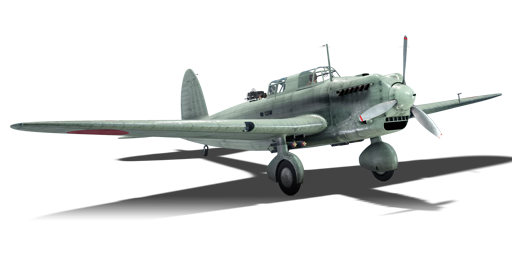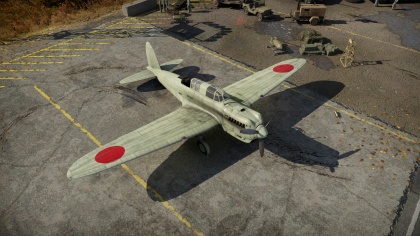Ki-32
Contents
Description
The Ki-32 is a Rank I Japanese light bomber
with a battle rating of 1.0 (AB) and 1.3 (RB/SB). It was introduced in Update 1.79 "Project X".
The first thing you will notice upon flying the Ki-32 is that it is incredibly nimble, especially in AB. It can out-turn anything that's not a bi-plane. A spaded Ki-32 with no bombs can out-turn early Spitfires, and a smart pilot will use this incredible maneuverability to their advantage. However, all this maneuverability comes at a dangerous cost. With no armor, a vulnerable cockpit and an airframe so weak it makes an I-16 look sturdy, you cannot afford to take any damage. As such, you should avoid engagements at all costs.
As a low flying light bomber, your first priority should be bombing ground targets as bombing bases is impractical, due to your bombs dealing low amounts of damage to them. While your 9 x 50 kg bombs are efficient at killing lightly armored targets like armored cars and AAA, and your 100 kg bombs can kill light tanks, any heavily armored target like medium and heavy tanks or destroyers will shrug them off.
Bombing bases is impractical, as your bombs deal low amounts of damage to them.
The Ki-32 also is very slow even when upgraded. With a stock top speed of 403 kph/250 mph and a spaded speed of 442 kph/275 mph, you will struggle to outrun anything that is not a Po-2.
General info
Flight Performance
Describe how the aircraft behaves in the air. Maximum speed, maneuverability, speed and allowable loads - these are the most important characteristics of the vehicle.
| Characteristics | |||||||
|---|---|---|---|---|---|---|---|
| Stock | |||||||
| Max Speed (km/h at 3,950 m) |
Max altitude (meters) |
Turn time (seconds) |
Rate of climb (meters/second) |
Take-off run (meters) | |||
| AB | RB | AB | RB | AB | RB | ||
| 403 | 395 | 7000 | 14.8 | 15.2 | 5.8 | 5.5 | 300 |
| Upgraded | |||||||
| Max Speed (km/h at 3,950 m) |
Max altitude (meters) | Turn time (seconds) | Rate of climb (meters/second) |
Take-off run (meters) | |||
| AB | RB | AB | RB | AB | RB | ||
| 442 | 423 | 7000 | 13.1 | 14.0 | 12.4 | 7.6 | 300 |
Details
| Features | ||||
|---|---|---|---|---|
| Combat flap | Take-off flap | Landing flap | Air brakes | Arrestor gear |
| X | ✓ | ✓ | X | X |
| Limits | ||||
|---|---|---|---|---|
| Wing-break speed (km/h) |
Gear limit (km/h) |
Combat flap (km/h) |
Max Static G | |
| + | - | |||
| 600 | 600 | ??? | ~11 | ~8 |
| Optimal velocities | |||
|---|---|---|---|
| Ailerons (km/h) |
Rudder (km/h) |
Elevators (km/h) |
Radiator (km/h) |
| < ??? | < ??? | < ??? | > ??? |
| Compressor (RB/SB) | ||
|---|---|---|
| Setting 1 | ||
| Optimal altitude | 100% Engine power | WEP Engine power |
| ?,??? m | ??? hp | ?,??? hp |
Survivability and armour
Examine the survivability of the aircraft. Note how vulnerable the structure is and how secure the pilot is, whether the fuel tanks are armoured. Describe the armour, if there is any, also mention the vulnerability of other critical aircraft systems.
Armaments
Offensive armament
The Ki-32 is armed with:
- 1 x 7.7 mm Type 89 machine gun, wing-mounted (135 rpg)
Suspended armament
{{main|:Category:Suspended armaments|l1=Bombs]]
The Ki-32 can be outfitted with the following ordnance:
- 9 x 50 kg Army Type 94 GPHE bombs
- 4 x 100 kg Army Type 94 GPHE bombs
Defensive armament
The Ki-32
- 2 x 7.7 mm Type 89 machine gun, dorsal turret (135 rpg = 270 total)
Usage in battles
The Ki-32 is a low flying bomber, so you should stay near the ground in order to destroy the ground targets. Do not bother with medium or heavy tanks, as your measly 100k g bombs do almost nothing to them so go for targets like pillboxes, light tanks, AAA and armoured cars.
Manual Engine Control
| MEC elements | ||||||
|---|---|---|---|---|---|---|
| Mixer | Pitch | Radiator | Supercharger | Turbocharger | ||
| Oil | Water | Type | ||||
| Controllable | Not controllable | Not controllable | Not controllable | Separate | Not controllable | Not controllable |
Modules
| Tier | Flight performance | Survivability | Weaponry | ||
|---|---|---|---|---|---|
| I | Fuselage Repair | Radiator | Offensive 7 mm | ||
| II | Compressor | Airframe | New 7 mm MGs | 10 in (mod24) | |
| III | Wings Repair | Engine | Turret 7 mm | ||
| IV | Engine Injection | Cover | New 7 mm MGs (Turret) | ||
- Being a bomber, acquiring the 10 inch (mod 24) module should be top priority. The weak airframe means that getting the survivability modules will help you survive attacks from unwanted visitors.
- New turret belts are beneficial as the gunner's stock belts contain ball ammunition which is almost useless.
Pros and cons
Pros:
- Fantastic maneuverability for a light bomber
- Small target
- Fast firing defensive armament that covers a lot of area
- Minimum fuel load is 35 minutes
Cons:
- Weak airframe
- No armor whatsoever
- Slow even after upgrades
- Weak offensive armament
- 4 x 100 kg bombs are useless versus heavy armor
- No self-sealing fuel tanks
- Fires will almost certainly down the plane (wood, fabric and fuel)
- It will most likely lose head-ons due to lack of armor
History
The Ki-32 was developed in response to a 1936 Imperial Japanese Army specification to replace the aging and inferior Ki-3. Both Mitsubishi and Kawasaki were requested to build two prototypes by Christmas. The specification required a top speed of 400 kph at 3,000 m with a normal operating altitude from 2,000 - 4,000 m and the ability to climb to that height in 8 minutes. The companies needed to choose between utilizing an 825 hp Mitsubishi Ha-6 radial, an 850 hp Nakajima Ha-5 radial or an 850 hp Kawasaki Ha-9-IIb liquid cooled inline engines.
The bomber also needed to conform to the following parameters:
- Have a normal bomb load of 300 kg
- Have a maximum payload of 450 kg
- One forward firing machine gun
- At least one flexible rear turret
- The ability to perform 60-degree dives for dive bombing
- Have a fully loaded weight of less than 3,300 kg.
The first Kawasaki prototype flew in 1937 and seven more prototypes were produced. The Kawasaki Ki-32 and Mitsubishi Ki-30 were virtually identical in terms of layout and performance, the main difference between the two were the engines. Mitsubishi used the Nakajima Ha-5 14-cylinder air-cooled radial engine, whereas Kawasaki opted to use their own Ha-9-IIb inline V12 engine.
The Kawasaki design encountered engine cooling problems, thus awarding the Mitsubishi Ki-30 the production order. Despite this, the need for aircraft in the Second Sino-Japanese war, which had started at full scale in July 1937, allowed the Ki-32 to enter production 12 months behind its rival. However, there were more Ki-32's built than Ki-30 despite being an inferior plane.
The Ki-32 was used extensively during the Sino-Japanese War, equipping the 3rd, 6th, 10th, 35th, 45th, 65th and 75th Sentai. It saw combat during the Battle of Nomonhan against Russia in 1938-1939. The plane saw its last combat action with the Imperial Japanese Army bombing the Commonwealth forces during the Japanese invasion of Hong Kong.
During WWII, the Ki-32 were supplied to the Manchukuo Air Force in order to replace Kawasaki's old Type 88/KDA-2 light bombers, and were the main bombers of the service through the war.
It was finally withdrawn from military service in 1942 and was re-purposed as a training plane.
Media
An excellent addition to the article will be video guides, as well as screenshots from the game and photos.
See also
Links to the articles on the War Thunder Wiki that you think will be useful for the reader, for example:
- reference to the series of the aircraft;
- links to approximate analogues of other nations and research trees.
External links
| Japan bombers | |
|---|---|
| Navy | |
| Carrier-based attack bomber | |
| B5N | B5N2 |
| B6N | B6N1 · B6N2 · B6N2a |
| B7A | B7A2 · B7A2 (Homare 23) |
| Carrier-based dive bomber | |
| D3A | D3A1 |
| D4Y | D4Y1 · D4Y2 · D4Y3 Ko |
| Shipboard Observation seaplane | |
| F1M | F1M2 |
| Land-based Attack bomber | |
| G4M | G4M1 |
| G5N | G5N1 |
| G8N | G8N1 |
| Flying boat | |
| H6K | H6K4 |
| H8K | H8K2 · H8K3 |
| Land-based Bomber | |
| P1Y | P1Y1 |
| Army | |
| Light | Ki-32 |
| Ki-48-II otsu | |
| Heavy | Ki-21-Ia · Ki-21-I hei |
| Ki-49-I · Ki-49-IIa · Ki-49-IIb · Ki-49-IIb/L | |
| Ki-67-I Ko · Ki-67-I otsu | |
| Other countries | ▅B-17E |





